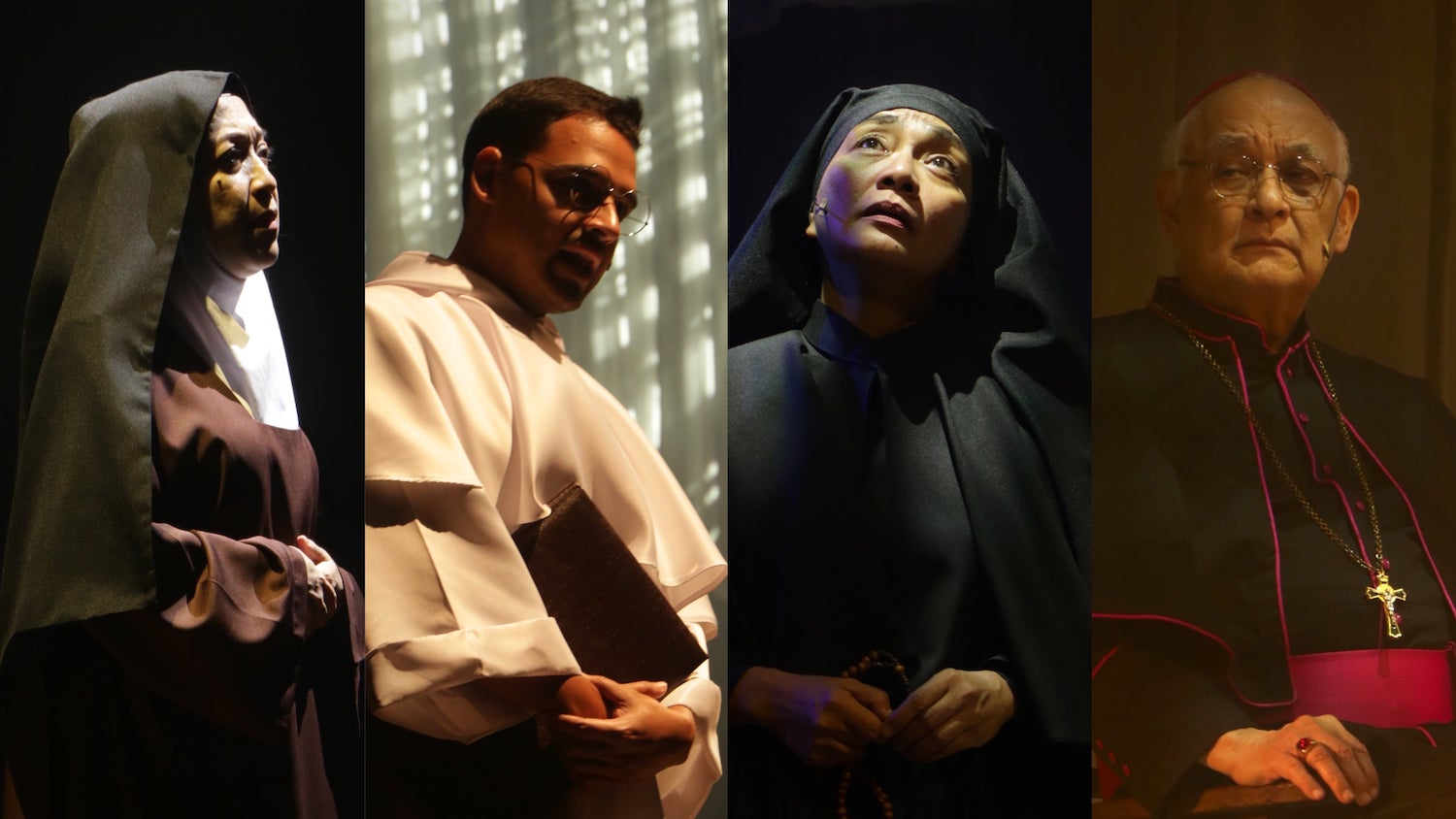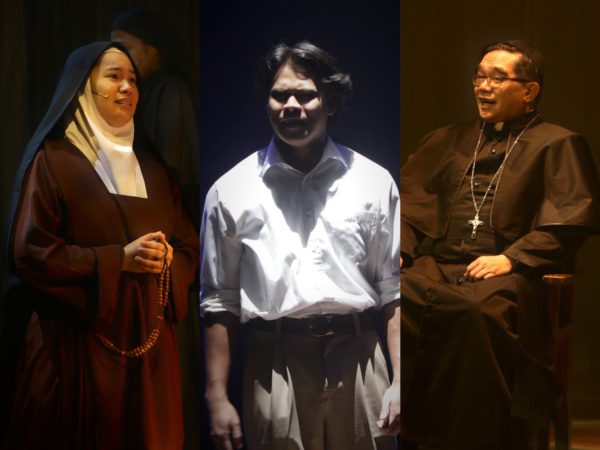
REVIEW: GRACE is a powerfully transcendent warning of the perils of blind obedience to authority
GRACE relies on the power of theater’s essential elements—a bold script by Floy Quintos, simple staging, and talented actors—to create an enlightening experience for the audience.
In the ruins of post-World War II Batangas, an aspiring nun speaks with the Virgin Mary. Local church authorities celebrate, but Rome and the Pope’s representative do not. Thus the stage is set for Floy Quintos’s final play, completed before his recent passing. Quintos has always gravitated towards stories that put nation-making and the Filipino people above all, even commerce. This is apparent in his latest masterpiece.
After showing the deep wounds in Philippine society due to politics in The Reconciliation Dinner, Quintos now takes on another giant institution: the Catholic Church, which Quintos describes in the play as “a church ruled by men, but a church of God, still.” The story that follows shows how different people, utterly convinced that they are doing what is best for their beloved church, tragically uphold perceived righteousness over the greatest of commandments: love and charity.
Grace begins with the noise of a wooden clapper, immediately plunging the audience into a different world; the same as ours, yet removed and medieval in outlook. It is a world where nuns walk barefoot, and are forbidden to leave the convent or be seen by men.
Actors come out one by one, giving mini monologues about their involvement in the controversial Marian apparitions of Lipa in 1948. It was freakishly uncanny how closely the selected thespians resembled the actual historical figures, whose names and photos were projected onto Mitoy Sta. Ana’s overhanging curtains. I appreciated how they clearly delineated fact from fiction, by showing which characters were combined (Bishops Obviar and Verzoza were merged as Monsignor Alfredo) and who weren’t.

L-R: Missy Maramara, Jojo Cayabyab, Shamaine Centenera-Buencamino; Photos by Abe Autea
Next, Steven Tansiongco’s projections tell us that the Carmelite nuns built the convent on the site of a massacre, where the Japanese killed over a thousand civilians in Lipa, Batangas. Where the earth has drunk deep of the blood of innocents, a few years later, a young girl studying to be a nun sees and speaks with a vision who calls herself Mary Mediatrix of All Grace.
There is a modesty in the production that only serves to heighten the impact of the key ingredients of theater all the more. We only have simple white curtains with images or news articles projected on them. There is a scarcity of props: chairs and implements are brought out by actors as needed. Director Dexter M. Santos had his actors speak in the soft gentle tones most religious adopt, for the most part, setting us up neatly for mini heart attacks at the mere bang of a hand, making the climactic scenes truly heart-wrenching.
There are few today who are familiar with this story, because it was hushed up after the Vatican proclaimed the Lipa apparitions of 1948 to be a hoax. There is another timeline to this saga that takes place in 1991 with another set of alleged miracles, but Quintos chose not to include this anymore, and focused exclusively on the beginning of the tale that has all the elements of the most exciting melodrama. That Quintos/Santos chose to present the story as carefully and cleanly as they did, shows that they put the story (and the truth as they see it) above theatrics. The script itself is so rich in themes that anything apart from a spartan set design would detract from it.
The totality of the production is the complete opposite of spectacle and no less impactful for it.
There are fewer laughs in this serious three-hour talkie than previous Quintos plays, for the stakes are higher: no less than eternal salvation. (Or damnation.) But pockets of laughter are there nonetheless; a necessary break to the mounting tension of seeing the ecclesiastical pressure build up to its predictable yet heartbreaking conclusion.
To gather such an ensemble cast is a blessing in itself, with each actor disappearing so completely in their roles, with glances and faces saying so much, with gestures speaking volumes. Leo Rialp’s performance as the papal nuncio Monsignor Vagnozzi is an absolute tour-de-force, a villain with a faultless Italian accent so spine-tingling to behold because he truly believes his actions are serving the greater good. A bespectacled Nelsito Gomez plays idealistic and impassioned Father Angel de Blas, bringing a youthful energy to the psychologist-rector of UST whose journal (discovered only in 2017/2018) carries perhaps the heaviest weight as he was both a man of science and God.
It was quite novel to see the actresses walk onstage with what looks like no makeup at all, as suits the nuns they portrayed. The magnetic Shamaine Centenera-Buencamino was a very motherly Mother Cecilia, the all-too-human prioress who saw an opportunity for reflected glory and took it. Frances Makil-Ignacio was refreshing to behold as Sister Agatha, the out-sister whose simple soul and lively chatter showed the best of good natured Pinoy humor. Missy Maramara’s understated lines spoke volumes as she played the doubting Sister Lucia, whose accusations of lesbian favoritism brought the heavy hand of church authority down on Carmel Lipa. Dennis Marasigan’s seemingly benign face and voice as Monsignor Rufino Santos hides a cold and calculating nature that ultimately makes him the first Filipino cardinal, perhaps a reward for how he helped deal with Carmel.

L-R: Matel Patayon, Raphne Catorce, Dennis Marasigan; Photos by Abe Autea
When she first walked onstage, I thought that Stella Cañete-Mendoza seemed a surprising choice to portray Teresita Castillo, the visionary of Lipa who was only 21 at the time, but that thought quickly dissolved once she spoke and transformed into an innocent lass reared on music and Mama Mary. And when she walked onstage again as the aging Teresita at the end, bent with age and the burden of her great cross, it nearly broke me.
The show was absolutely engrossing, I did not feel the passage of time in this nearly three-hour long play.
Vexing and challenging to behold, one cannot watch Grace and remain unmoved. While the personal slant of the playwright towards the miracles was evident, the play will speak to people even of the opposite religious inclination. For all can relate to its purpose: it champions independent thought in what sometimes feels like a blend of theocracy and cults of personality. It calls out abusive authoritarians who would have us live in a democracy in name only. It is critical of the abuse of power by authorities who care more for money and hierarchy than catering to the faith of their flock. It is also very easy to see the parallels with contemporary times: with the erasure of history, and the punishment of all who refuse to be obediently silent.
Truly, Grace is an act of faith in the primal power of theater’s most important cornerstones. The communion of the simplest of stagings highlighting Floy Quintos’ bold script, voiced by the finest actors, is all it takes for the minor miracle of enlightenment to take place.
At the end, the audience rose to its feet and gave a standing ovation while brushing away tears.
And yes, it should come with a warning that it offers no easy answers; if anything, it will create doubt. It will make one question rulings made over 70 years ago. But this is, perhaps, the goal of the play. After all, if faith is untried, is it still faith?
Tickets: P1,500-P2,000
Show Dates: May 25-June 16, 2024 (3:00 PM / 8:00 PM)
Venue: Power Mac Center Spotlight Blackbox Theater, Circuit Makati
Running Time: 2 hours 55 minutes (including a 15 minute intermission)
Credits: Floy Quintos (Playwright), Dexter M. Santos (Director), Mitoy Sta. Ana (Production Design), John Batalla (Lighting Design), Arvy Dimaculangan (Music & Sound Design), Steven Tansiongco (Video & Graphics Design), Marvin Olaes and Davidson Oliveros (Dramaturgy), Meliton Roxas Jr. (Technical Director), Mikko Angeles (Assistant Director), Lexi Bartolome and Ronah Adiel De La Peña (Production Managers), and Mara Agleham (Stage Manager)
Cast: Stella Cañete-Mendoza (Teresita Castillo), Shamaine Centenera-Buencamino (Mother Cecilia of Jesus), Frances Makil-Ignacio (Sister Agatha), Missy Maramara (Sister Lucia), Matel Patayon (Sister/Nurse), Leo Rialp (Monsignor Egidio Vagnozzi), Dennis Marasigan (Monsignor Rufino Santos), Nelsito Gomez (Father Angel de Blas), Jojo Cayabyab (Monsignor Alfredo), and Raphne Catorce (Guillermo)
Company: Encore Theater


Comments